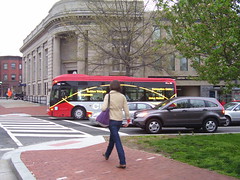I sound like a broken record even to me when it comes to a preference for broad-based planning

According to a DDOT press release, "DC Circulator Launches Planning Study: Six Month Project Will Map System’s Future," they have convened a transportation study to:
guide the expansion of the DC Circulator over the next five to ten years. This comprehensive study will enlist the help of riders and other stakeholders to evaluate the current system and identify future corridors for new service.
What's frustrating about this is that is too narrowly construed, and is independent of a broad planning effort for transit services in the District.
Sure there's the Transportation Element in the Comprehensive Plan + the recent DDOT Action Plan, but what's necessary is a comprehensive transportation plan which places the Circulator within a broad framework of services.
The framework as promoted in this display board (below) at various public meeting is more idiosyncratic than systematic.

What the Circulator bus system offers is a legible service (the buses have a nice graphic treatment and the bus stop information systems are better than for traditional Metrobus services) that is frequent--every 10 minutes.
However, generally to run a bus line with that frequency you need a fair amount of ridership, I'd estimate, at least 10,000 riders/day, and most of the newer Circulator bus services don't meet that standard.
The thing that needs to be done is the creation of an overt high frequency surface transit system. We have the makings of it with certain services, but bus prioritization hasn't occurred in the places where it is needed, primarily downtown.
And high frequency bus services, other than the Circulator, aren't marketed or differentiated from other service. This needs to change.
These questions don't get addressed because of people being more enthralled with the type of bus, the graphics, and the allied information systems. Instead, quality of the bus, the graphic identity, and the allied information systems need to be improved overall. (This is happening in terms of the quality of the bus, as Metrobus has pretty much replaced the old buses with new ones.)
The other thing is that the city needs to address providing intra-neighborhood transit services in a cost-effective but comprehensive manner. Likely that doesn't mean service every 10 minutes, but there is likely a reasonable position between no service and service every 10 minutes that it cost-effective.
Providing service frequency for buses that are mostly empty (such as the Capitol Hill-Navy Yard Circulator) does not do us any favors.

The Union Station-Navy Yard DC Circulator uses 30 foot buses.
(Also see this blog entry: Metropolitan Mass Transit Planning presentation.)
Labels: mobility shed, transit, transit shed, transportation planning



0 Comments:
Post a Comment
<< Home